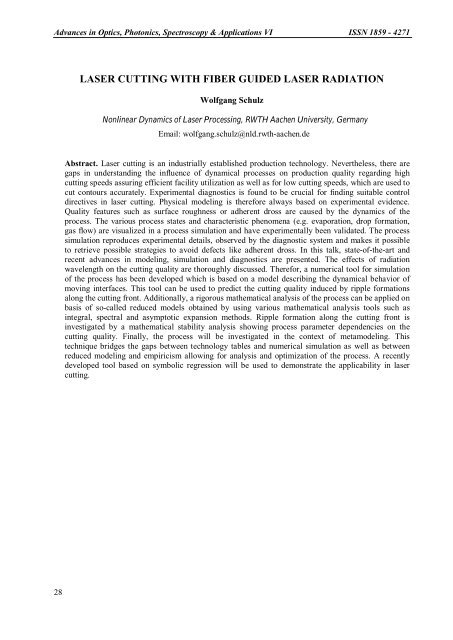Nhng tin b trong Quang hc, Quang ph và ng dng VI ISSN 1859 - 4271
Nhng tin b trong Quang hc, Quang ph và ng dng VI ISSN 1859 - 4271
Nhng tin b trong Quang hc, Quang ph và ng dng VI ISSN 1859 - 4271
Create successful ePaper yourself
Turn your PDF publications into a flip-book with our unique Google optimized e-Paper software.
Advances in Optics, Photonics, Spectroscopy & Applications <strong>VI</strong> <strong>ISSN</strong> <strong>1859</strong> - <strong>4271</strong>LASER CUTTING WITH FIBER GUIDED LASER RADIATIONWolfga<strong>ng</strong> SchulzNonlinear Dynamics of Laser Processi<strong>ng</strong>, RWTH Aachen University, GermanyEmail: wolfga<strong>ng</strong>.schulz@nld.rwth-aachen.deAbstract. Laser cut<s<stro<strong>ng</strong>>tro<strong>ng</strong></stro<strong>ng</strong>>>tin</s<stro<strong>ng</strong>>tro<strong>ng</strong></stro<strong>ng</strong>>>g is an industrially established production technology. Nevertheless, there aregaps in understandi<strong>ng</strong> the influence of dynamical processes on production quality regardi<strong>ng</strong> hig<stro<strong>ng</strong>>hc</stro<strong>ng</strong>>ut<s<stro<strong>ng</strong>>tro<strong>ng</strong></stro<strong>ng</strong>>>tin</s<stro<strong>ng</strong>>tro<strong>ng</strong></stro<strong>ng</strong>>>g speeds assuri<strong>ng</strong> efficient facility utilization as well as for low cut<s<stro<strong>ng</strong>>tro<strong>ng</strong></stro<strong>ng</strong>>>tin</s<stro<strong>ng</strong>>tro<strong>ng</strong></stro<strong>ng</strong>>>g speeds, which are used tocut contours accurately. Experimental diagnostics is found to be crucial for findi<strong>ng</strong> suitable controldirectives in laser cut<s<stro<strong>ng</strong>>tro<strong>ng</strong></stro<strong>ng</strong>>>tin</s<stro<strong>ng</strong>>tro<strong>ng</strong></stro<strong>ng</strong>>>g. Physical modeli<strong>ng</strong> is therefore always based on experimental evidence.Quality features such as surface roughness or adherent dross are caused by the dynamics of theprocess. The various process states and characteristic <stro<strong>ng</strong>>ph</stro<strong>ng</strong>>enomena (e.g. evaporation, drop formation,gas flow) are visualized in a process simulation and have experimentally been validated. The processsimulation reproduces experimental details, observed by the diagnostic system and makes it possibleto retrieve possible strategies to avoid defects like adherent dross. In this talk, state-of-the-art andrecent advances in modeli<strong>ng</strong>, simulation and diagnostics are presented. The effects of radiationwavele<strong>ng</strong>th on the cut<s<stro<strong>ng</strong>>tro<strong>ng</strong></stro<strong>ng</strong>>>tin</s<stro<strong>ng</strong>>tro<strong>ng</strong></stro<strong>ng</strong>>>g quality are thoroughly discussed. Therefor, a numerical tool for simulationof the process has been developed which is based on a model describi<strong>ng</strong> the dynamical behavior ofmovi<strong>ng</strong> interfaces. This tool can be used to predict the cut<s<stro<strong>ng</strong>>tro<strong>ng</strong></stro<strong>ng</strong>>>tin</s<stro<strong>ng</strong>>tro<strong>ng</strong></stro<strong>ng</strong>>>g quality induced by ripple formationsalo<strong>ng</strong> the cut<s<stro<strong>ng</strong>>tro<strong>ng</strong></stro<strong>ng</strong>>>tin</s<stro<strong>ng</strong>>tro<strong>ng</strong></stro<strong>ng</strong>>>g front. Additionally, a rigorous mathematical analysis of the process can be applied onbasis of so-called reduced models obtained by usi<strong>ng</strong> various mathematical analysis tools such asintegral, spectral and asymptotic expansion methods. Ripple formation alo<strong>ng</strong> the cut<s<stro<strong>ng</strong>>tro<strong>ng</strong></stro<strong>ng</strong>>>tin</s<stro<strong>ng</strong>>tro<strong>ng</strong></stro<strong>ng</strong>>>g front isinvestigated by a mathematical stability analysis showi<strong>ng</strong> process parameter dependencies on thecut<s<stro<strong>ng</strong>>tro<strong>ng</strong></stro<strong>ng</strong>>>tin</s<stro<strong>ng</strong>>tro<strong>ng</strong></stro<strong>ng</strong>>>g quality. Finally, the process will be investigated in the context of metamodeli<strong>ng</strong>. Thistechnique bridges the gaps between technology tables and numerical simulation as well as betweenreduced modeli<strong>ng</strong> and empiricism allowi<strong>ng</strong> for analysis and optimization of the process. A recentlydeveloped tool based on symbolic regression will be used to demonstrate the applicability in lasercut<s<stro<strong>ng</strong>>tro<strong>ng</strong></stro<strong>ng</strong>>>tin</s<stro<strong>ng</strong>>tro<strong>ng</strong></stro<strong>ng</strong>>>g.28















